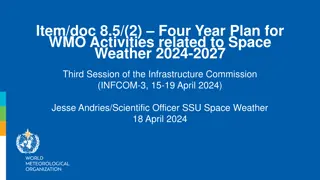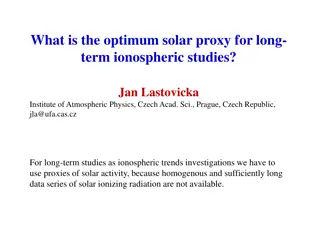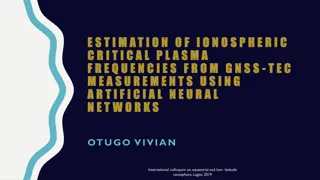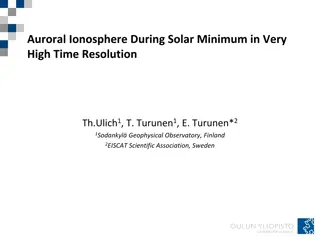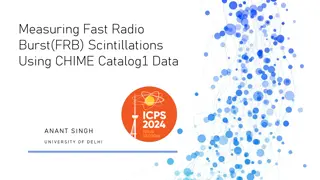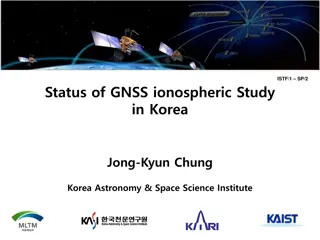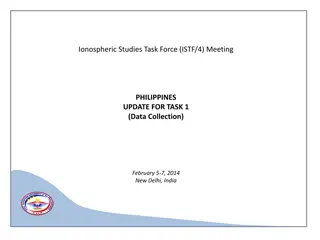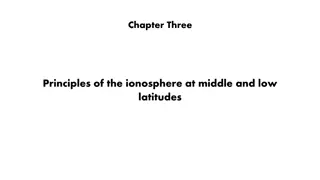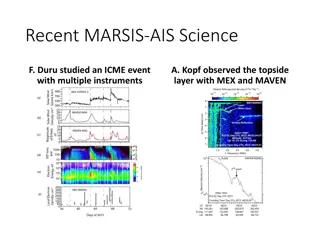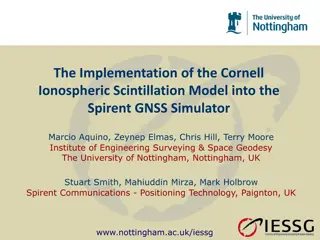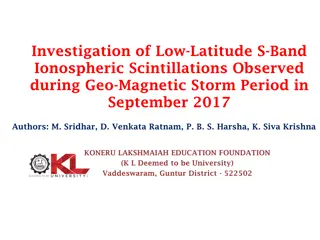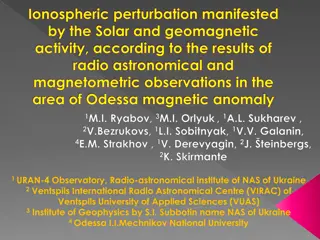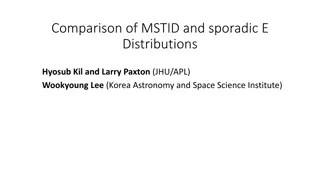Four-Year Plan for WMO Space Weather Activities 2024-2027
Space Weather is a crucial aspect of the natural space environment affecting various technologies on Earth and in space. The plan outlines goals, historical context, and key recommendations by INFCOM-3 for monitoring and modeling solar, magnetospheric, and ionospheric activities. Integration of Spac
0 views • 9 slides
Optimum Solar Proxy for Long-Term Ionospheric Studies
The search for the best solar proxy for long-term ionospheric studies is ongoing due to the lack of consistent solar radiation data. Various solar proxies have been analyzed, and the use of Mg II for foF2 and F10.7 for foE has shown promising results, describing a high percentage of variance in the
1 views • 10 slides
Estimation of Ionospheric Critical Plasma Frequencies Using GNSS Measurements
This research focuses on estimating the critical plasma frequency of the ionosphere, specifically the F2 layer (f0F2), using GNSS measurements. The study reviews past work on ionospheric modeling, discusses neural network training inputs, and presents a single station neural network model (NNT2F2).
0 views • 26 slides
Cutting-edge Technology at Sodankyl Geophysical Observatory
The Sodankyl Geophysical Observatory in Finland utilizes state-of-the-art technology for ionospheric research, including the Alpha-Wolf sounder, a sophisticated transmitter, and receiver array. The observatory has a rich history of ionosonde operations since 1957, with continuous advancements in dat
2 views • 23 slides
Exploring Fast Radio Bursts (FRBs) and Scintillations in the Universe
Fast Radio Bursts (FRBs) are millisecond-duration bursts of radio waves originating from outside our galaxy, offering researchers a unique opportunity to investigate baryon distributions and probe the cold gas clumps in the Universe. Scintillations in radio waves caused by irregularities in the inte
1 views • 25 slides
GNSS Ionospheric Study in Korea: Insights and Findings
Explore the status of GNSS ionospheric study in Korea, including details on Korea's GPS permanent network, IGS, KASI Global Data Center, TEC mapping, and ionospheric tomography. Discover how ground-based GPS data is used to study ionospheric electron densities and monitor ionospheric storms in Korea
0 views • 15 slides
Update on Ionospheric Studies Task Force (ISTF/4) Meeting in Philippines
The ISTF/4 meeting in Philippines provided updates on data collection tasks, including current and planned data sources. The report highlighted the total number of operating stations, types of data collected, and progress on new site installations. Additionally, updates on the use of data within CAA
0 views • 4 slides
Understanding Ionospheric Absorption Laws and Regions
The principles of the ionosphere at middle and low latitudes, Lambert-Beer exponential absorption law, and characteristics of E and F regions are discussed. The absorption of solar radiation, recombination reactions in different regions, and ionization processes are highlighted, providing insights i
0 views • 15 slides
Recent Insights into Mars Ionosphere Studies with MARSIS-AIS
Discover recent research on the Martian ionosphere conducted by scientists using various instruments such as MARSIS, MAVEN, and MarMCET. Explore studies on electron density profiles, ionospheric traces, and the timing issue correction of the AIS sounding cycle. Publications address improvements in a
0 views • 6 slides
Implementation of Cornell Ionospheric Scintillation Model in Spirent GNSS Simulator
Researchers from the University of Nottingham and Spirent Communications collaborated to implement the Cornell Ionospheric Scintillation Model into the Spirent GNSS Simulator. The study focuses on the diffractive effects of ionospheric scintillation on GNSS signals, examining small-scale plasma irre
0 views • 24 slides
Investigation of Low-Latitude S-Band Ionospheric Scintillations during September 2017 Geo-Magnetic Storm
The study focuses on analyzing the impact of geo-magnetic storms on NAVIC satellites, particularly the S-band signal, during September 2017. Researchers from K.L. Deemed to be University observed variations in solar and geomagnetic activity indices, providing insights into the behavior of the ionosp
0 views • 15 slides
Study on Ionospheric Perturbation Due to Solar and Geomagnetic Activity in Odessa Magnetic Anomaly
Research conducted in the area of the Odessa magnetic anomaly investigates ionospheric perturbations caused by solar and geomagnetic activity. The study utilizes radio astronomical and magnetometric observations from various observatories, highlighting the significance of the geomagnetic anomaly nea
0 views • 18 slides
Comparison of MSTID and Sporadic E Distributions in Ionosphere Study
Investigating the role of sporadic E in medium-scale traveling ionospheric disturbances by comparing its distribution with MSTID using CHAMP satellite data. Sporadic E and MSTID occurrences, detection methods, and distribution patterns in different hemispheres are explored, revealing seasonal variat
0 views • 9 slides
